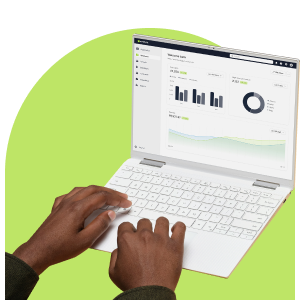One of the best ways for your business messaging to stand out is through the effective use of personalisation in your communication. Personalisation goes beyond simply addressing a recipient by name. It involves using data to tailor aspects of your communication to meet each recipient’s specific needs and preferences. When done correctly, personalisation can significantly boost your open rates, click-through rates, and overall engagement.
From Personalisation to Hyper-Personalisation
Hyper-personalisation is the new buzzword in the marketing industry, but what exactly does it mean?
In essence, it is taking personalisation as we know it one step further and leveraging real-time data and advanced technologies (like artificial intelligence and machine learning) to deliver an even more tailored individual experience to your recipients. By using data, like online browsing behaviour, past purchases, and engagement history, you can create highly individualised messages that resonate deeply with your audiences.
For example, if your comfort on a rainy day is pumpkin soup from a specific retail store, then hyper-personalisation would mean that specific retail store will send you an advertisement for pumpkin soup on a rainy day, possibly with a discount attached to it.
If you want to excel at hyper-personalisation, you need data! The more accurate the user data you have, the better your hyper-personalisation game will be.
Nine Ways You Can Personalise Your Communication
1. Personalising your Email Subject Line
The subject line is the first impression your email makes and personalising it can significantly boost your open rates. When recipients see their name or something specifically relevant to them in the subject line, it immediately grabs their attention.
For example, “Thabang, we’ve got a special offer just for you!” is far more compelling than a generic “Special offer inside!”
Personalising subject lines is easily achieved using tags and dynamic subject lines (available in email marketing platforms like Everlytic). These tools allow you to automatically insert personalised elements into your subject lines, making each email feel tailor-made for the recipient.
2. Adressing Recipients by Name
Addressing recipients by their first name in the email body is a simple and powerful way to create a sense of personal connection. It makes the email feel more like a one-on-one conversation rather than a mass marketing message.
Most email marketing platforms support the use of contact tags that automatically insert the recipient’s name into the email. For example, instead of starting your email with a generic greeting like “Hello,” you can use “Hi Nazeera, check out our latest products!”
This small touch can make a big difference in how your email is perceived, increasing the likelihood that it will be read and acted upon.
Improve your customer experience by using contact tagging in your personalisation strategy.
3. Making Use of Behavioural Triggers
A behavioural trigger is a powerful tool for automating personalised email responses based on specific actions taken by your recipients. These triggers allow you to send timely and relevant emails that respond directly to user behaviour.
For example, you can set up automated emails to be sent when a customer abandons their shopping cart, completes a purchase, or signs up for your newsletter. Setting up these triggers usually involves defining specific actions and creating corresponding email workflows in your email marketing platform.
The benefits of behaviour-triggered emails include increased relevance, higher open and click-through rates, and improved customer satisfaction, as recipients receive emails that are timely and directly related to their actions.
4. Sharing Tailored Offers and Promotions
By analysing customer data like past purchase history, browsing behaviour, and preferences, you can create highly relevant offers more likely to resonate with each recipient.
For example, you might offer a discount on a product category a customer has shown interest in or provide a special loyalty reward for frequent buyers.
Personalised promotions not only increase the likelihood of conversions but also foster customer loyalty and repeat business. Crafting these offers involves leveraging your email marketing platform’s data analysis and segmentation tools to ensure each recipient receives the most relevant and enticing offers.
5. Utilising Past Purchase Data
By leveraging past data and analysing recipients’ previous purchases, you can tailor your emails to suggest complementary products, offer-related items, or highlight upcoming sales on similar products. This approach demonstrates that you understand your recipients’ preferences and increases the chances of cross-selling and upselling.
For instance, if a customer recently purchased a camera, you could follow up with recommendations for lenses, tripods, or photography courses. Additionally, sending personalised emails that acknowledge past purchases, such as “Thank you for your recent purchase! You might also like…” can build stronger customer relationships and encourage repeat business.
6. Implementing Location-Based Personalisation
Location-based personalisation allows you to tailor your emails to the recipient’s geographic location, enhancing relevance and engagement. By using IP geolocation or user-provided location data, you can include location-specific content, such as local store events, regional promotions, or weather-related product recommendations.
For example, a retail chain could send an email promoting a sale at the nearest store to the recipient, or a travel company could highlight vacation packages departing from the recipient’s closest airport.
7. Taking Note of Email Frequency Preferences
Adjusting email frequency based on user preferences can significantly improve the recipient’s experience and reduce the likelihood of unsubscribes. Platforms like Everlytic offer data analytics and reports that you can use to analyse engagement data and automatically adjust email frequency for each recipient, sending more emails to highly engaged users and fewer to those that are less active.
8. Making Segmentation and Targeted Content Part of your Strategy
Segmentation is a powerful approach that involves dividing your email list into smaller, more targeted groups based on specific criteria. Common methods of segmentation include demographics (such as age, gender, or location), past purchase behaviour, engagement levels, and interests.
For instance, you might create segments for frequent buyers, first-time customers, and inactive subscribers. Each segment will receive different content that resonates with their unique needs and behaviours. The benefits of segmentation are clear: more relevant content leads to higher open rates, click-through rates, and ultimately, better campaign performance.
Personalisation encompasses techniques and features at different levels, from entry-level to mid-level and advanced.
9. Learning More About Dynamic Content Blocks
Dynamic content blocks allow you to create hyper-personalised emails by displaying different pieces of content to different recipients within the same email template. This means you can tailor parts of your email to match the specific interests, behaviours, or preferences of each recipient.
Setting up dynamic content blocks is straightforward with many email marketing platforms. You can define rules based on your segmentation criteria to show different images, offers, or messages.
For example, a clothing retailer might display men’s clothing to male recipients and women’s clothing to female recipients within the same campaign. This level of personalisation ensures that your emails are relevant to each recipient, enhancing their engagement and likelihood of them taking action.
Better Personalisation, Better Communication, Better Results
Incorporating personalisation into your bulk email communication will help you stand out in recipients’ crowded inboxes. By implementing the techniques discussed, like personalising subject lines, using recipient names, leveraging segmentation, and utilising dynamic content, you can create more engaging and relevant emails that will lead to better communication and better results!
Personalisation is Easy with Our Bulk Communication Platform
Easily create and send personalised, automated business communications with flair to drive your bulk campaign results and boost client engagement by using the Everlytic communication platform.



